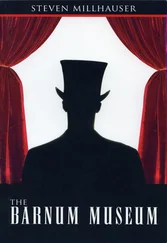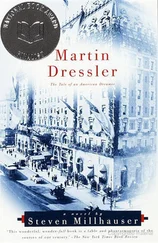Steven Millhauser - Eisenheim the Illusionist
Здесь есть возможность читать онлайн «Steven Millhauser - Eisenheim the Illusionist» весь текст электронной книги совершенно бесплатно (целиком полную версию без сокращений). В некоторых случаях можно слушать аудио, скачать через торрент в формате fb2 и присутствует краткое содержание. Город: New York, Год выпуска: 1994, ISBN: 1994, Издательство: Atlantic Monthly Press, Жанр: Современная проза, на английском языке. Описание произведения, (предисловие) а так же отзывы посетителей доступны на портале библиотеки ЛибКат.
- Название:Eisenheim the Illusionist
- Автор:
- Издательство:Atlantic Monthly Press
- Жанр:
- Год:1994
- Город:New York
- ISBN:978-0871134837
- Рейтинг книги:5 / 5. Голосов: 1
-
Избранное:Добавить в избранное
- Отзывы:
-
Ваша оценка:
- 100
- 1
- 2
- 3
- 4
- 5
Eisenheim the Illusionist: краткое содержание, описание и аннотация
Предлагаем к чтению аннотацию, описание, краткое содержание или предисловие (зависит от того, что написал сам автор книги «Eisenheim the Illusionist»). Если вы не нашли необходимую информацию о книге — напишите в комментариях, мы постараемся отыскать её.
Eisenheim the Illusionist — читать онлайн бесплатно полную книгу (весь текст) целиком
Ниже представлен текст книги, разбитый по страницам. Система сохранения места последней прочитанной страницы, позволяет с удобством читать онлайн бесплатно книгу «Eisenheim the Illusionist», без необходимости каждый раз заново искать на чём Вы остановились. Поставьте закладку, и сможете в любой момент перейти на страницу, на которой закончили чтение.
Интервал:
Закладка:
Eisenheim the Illusionist
In the last years of the nineteenth century, when the Empire of the Hapsburgs was nearing the end of its long dissolution, the art of magic flourished as never before. In obscure villages of Moravia and Galicia, from the Istrian Peninsula to the mists of Bukovina, bearded and black-caped magicians in market squares astonished townspeople by drawing streams of dazzling silk handkerchiefs from empty paper cones, removing billiard balls from children's ears, and throwing into the air decks of cards that assumed the shapes of fountains, snakes, and angels before returning to the hand. In cities and larger towns, from Zagreb to Lvov, from Budapest to Vienna, on the stages of opera houses, town halls, and magic theaters, traveling conjurers equipped with the latest apparatus enchanted sophisticated audiences with elaborate stage illusions. It was the age of levitations and decapitations, of ghostly apparitions and sudden vanishings, as if the tottering Empire were revealing through the medium of its magicians its secret desire for annihilation. Among the remarkable conjurers of that time, none achieved the heights of illusion attained by Eisenheim, whose enigmatic final performance was viewed by some as a triumph of the magician's art, by others as a fateful sign.
Eisenheim, né Eduard Abramowitz, was born in Bratislava in 1859 or 1860. Little is known of his early years, or indeed of his entire life outside the realm of illusion. For the scant facts we are obliged to rely on the dubious memoirs of magicians, on comments in contemporary newspaper stories and trade periodicals, on promotional material and brochures for magic acts; here and there the diary entry of a countess or ambassador records attendance at a performance in Paris, Cracow, Vienna. Eisenheim's father was a highly respected cabinetmaker, whose ornamental gilt cupboards and skillfully carved lowboys with lion-paw feet and brass handles shaped like snarling lions graced the halls of the gentry of Bratislava. The boy was the eldest of four children; like many Brarislavan Jews, the family spoke German and called their city Pressburg, although they understood as much Slovak and Magyar as was necessary for the proper conduct of business. Eduard went to work early in his father's shop. For the rest of his life he would retain a fondness for smooth pieces of wood joined seamlessly by mortise and tenon. By the age of seventeen he was himself a skilled cabinetmaker, a fact noted more than once by fellow magicians who admired Eisenheim's skill in constructing trick cabinets of breathtaking ingenuity. The young craftsman was already a passionate amateur magician, who is said to have entertained family and friends with card sleights and a disappearing-ring trick that required a small beechwood box of his own construction. He would place a borrowed ring inside, fasten the box tightly with twine, and quietly remove the ring as he handed the box to a spectator. The beechwood box, with its secret panel, was able to withstand the most minute examination.
A chance encounter with a traveling magician is said to have been the cause of Eisenheim's lifelong passion for magic. The story goes that one day, returning from school, the boy saw a man in black sitting under a plane tree. The man called him over and lazily, indifferently, removed from the boy's ear first one coin and then another, and then a third, coin after coin, a whole handful of coins, which suddenly turned into a bunch of red roses. From the roses the man in black drew out a white billiard ball, which turned into a wooden flute that suddenly vanished. One version of the story adds that the man himself then vanished, along with the plane tree. Stories, like conjuring tricks, are invented because history is inadequate to our dreams, but in this case it is reasonable to suppose that the future master had been profoundly affected by some early experience of conjuring. Eduard had once seen a magic shop, without much interest; he now returned with passion. On dark winter mornings on the way to school he would remove his gloves to practice manipulating balls and coins with chilled fingers in the pockets of his coat. He enchanted his three sisters with intricate shadowgraphs representing Rumpelstiltskin and Rapunzel, American buffaloes and Indians, the golem of Prague. Later a local conjurer called Ignazc Molnar taught him juggling for the sake of coordinating movements of the eye and hand. Once, on a dare, the thirteen-year-old boy carried an egg on a soda straw all the way to Bratislava Castle and back. Much later, when all this was far behind him, the Master would be sitting gloomily in the corner of a Viennese apartment where a party was being held in his honor, and reaching up wearily he would startle his hostess by producing from the air five billiard balls that he proceeded to juggle flawlessly.
But who can unravel the mystery of the passion that infects an entire life, bending it away from its former course in one irrevocable swerve? Abramowitz seems to have accepted his fate slowly. It was as if he kept trying to evade the disturbing knowledge of his difference. At the age of twenty-four he was still an expert cabinetmaker who did occasional parlor tricks.
As if suddenly, Eisenheim appeared at a theater in Vienna and began his exhilarating and fatal career. The brilliant newcomer was twenty-eight years old. In fact, contemporary records show that the cabinetmaker from Bratislava had appeared in private performances for at least a year before moving to the Austrian capital. Although the years preceding the first private performances remain mysterious, it is clear that Abramowitz gradually shifted his attention more and more fully to magic, by way of the trick chests and cabinets that he had begun to supply to local magicians. Eisenheim's nature was like that: he proceeded slowly and cautiously, step by step, and then, as if he had earned the right to be daring, he would take a sudden leap.
The first public performances were noted less for their daring than for their subtle mastery of the stage illusions of the day, although even then there were artful twists and variations. One of Eisenheim's early successes was The Mysterious Orange Tree, a feat made famous by Robert-Houdin. A borrowed handkerchief was placed in a small box and handed to a member of the audience. An assistant strode onto the stage, bearing in his arms a small green orange tree in a box. He placed the box on the magician's table and stepped away. At a word from Eisenheim, accompanied by a pass of his wand, blossoms began to appear on the tree. A moment later, oranges began to emerge; Eisenheim plucked several and handed them to members of the audience. Suddenly two butterflies rose from the leaves, carrying a handkerchief. The spectator, opening his box, discovered that his handkerchief had disappeared; somehow the butterflies had found it in the tree. The illusion depended on two separate deceptions: the mechanical tree itself, which produced real flowers, real fruit, and mechanical butterflies by means of concealed mechanisms; and the removal of the handkerchief from the trick box as it was handed to the spectator. Eisenheim quickly developed a variation that proved popular: the tree grew larger each time he covered it with a red silk cloth, the branches produced oranges, apples, pears, and plums, at the end a whole flock of colorful, real butterflies rose up and fluttered over the audience, where children screamed with delight as they reached up to snatch the delicate silken shapes, and at last, under a black velvet cloth that was suddenly lifted, the tree was transformed into a bird-cage containing the missing handkerchief.
At this period, Eisenheim wore the traditional silk hat, frock coat, and cape and performed with an ebony wand tipped with ivory. The one distinctive note was his pair of black gloves. He began each performance by stepping swiftly through the closed curtains onto the stage apron, removing the gloves, and tossing them into the air, where they turned into a pair of sleek ravens.
Читать дальшеИнтервал:
Закладка:
Похожие книги на «Eisenheim the Illusionist»
Представляем Вашему вниманию похожие книги на «Eisenheim the Illusionist» списком для выбора. Мы отобрали схожую по названию и смыслу литературу в надежде предоставить читателям больше вариантов отыскать новые, интересные, ещё непрочитанные произведения.
Обсуждение, отзывы о книге «Eisenheim the Illusionist» и просто собственные мнения читателей. Оставьте ваши комментарии, напишите, что Вы думаете о произведении, его смысле или главных героях. Укажите что конкретно понравилось, а что нет, и почему Вы так считаете.












